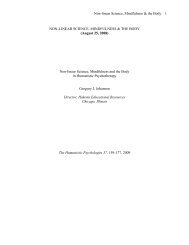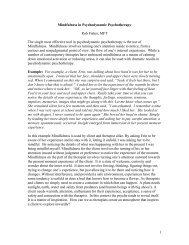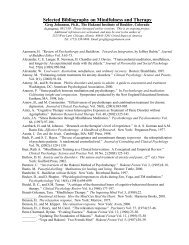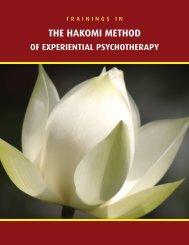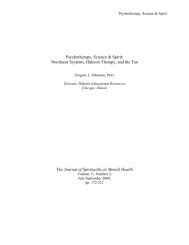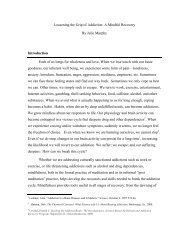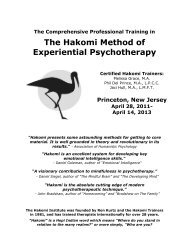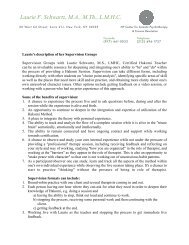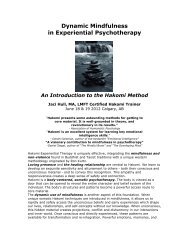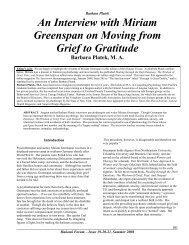The Buddha's Influence in the Therapy Room - Hakomi Institute
The Buddha's Influence in the Therapy Room - Hakomi Institute
The Buddha's Influence in the Therapy Room - Hakomi Institute
You also want an ePaper? Increase the reach of your titles
YUMPU automatically turns print PDFs into web optimized ePapers that Google loves.
elat<strong>in</strong>g to meditation and my discussion centres on <strong>the</strong><br />
practices of this school.<br />
In <strong>the</strong> eightfold path, right effort, right concentration, and<br />
right m<strong>in</strong>dfulness are promoted as important factors <strong>in</strong><br />
meditation. Of <strong>the</strong> three, right m<strong>in</strong>dfulness is regarded as<br />
<strong>the</strong> most critical factor for as Nyanaponika (1992) expla<strong>in</strong>s,<br />
m<strong>in</strong>dfulness is “<strong>the</strong> heart of Buddhist meditation.”<br />
Bel<strong>in</strong>da Siew Luan Khong<br />
<strong>The</strong> Buddhist practice of m<strong>in</strong>dfulness is based on <strong>the</strong> four<br />
foundations of m<strong>in</strong>dfulness (satipatthāna), that is<br />
ma<strong>in</strong>ta<strong>in</strong><strong>in</strong>g cont<strong>in</strong>uous awareness of (1) <strong>the</strong> body (e.g. <strong>the</strong><br />
breath, posture, bodily sensations etc) (2) feel<strong>in</strong>gs (whe<strong>the</strong>r<br />
pleasant, unpleasant, or neutral) (3) states of m<strong>in</strong>d (e.g.<br />
depressed, anxious , angry and so forth) and (4) <strong>the</strong> mental<br />
contents (<strong>the</strong> objects or thoughts occupy<strong>in</strong>g <strong>the</strong> m<strong>in</strong>d at a<br />
given moment) (Nyanaponika, 1992; Goleman, 1984).<br />
Briefly, right concentration <strong>in</strong>volves focus<strong>in</strong>g <strong>the</strong> m<strong>in</strong>d on<br />
one stimulus, such as <strong>the</strong> breath, mantra, lov<strong>in</strong>g k<strong>in</strong>dness,<br />
chant<strong>in</strong>g etc., (<strong>the</strong> objects of meditation) to <strong>the</strong> exclusion of<br />
o<strong>the</strong>r stimuli. Right effort refers to <strong>the</strong> application of <strong>the</strong><br />
right amount of effort to susta<strong>in</strong> this concentration, and to<br />
prevent negative (unwholesome) thoughts from <strong>in</strong>trud<strong>in</strong>g.<br />
By enabl<strong>in</strong>g <strong>the</strong> m<strong>in</strong>d to stay focused, this practice of “onepo<strong>in</strong>tedness”<br />
reduces <strong>the</strong> m<strong>in</strong>d’s tendency to rum<strong>in</strong>ate and<br />
become distracted. While tranquillity meditation focuses<br />
ma<strong>in</strong>ly on <strong>the</strong> cultivation of right concentration, <strong>in</strong>sight<br />
meditation emphasizes <strong>the</strong> cultivation of right m<strong>in</strong>dfulness<br />
and observation (Rahula, 1978).<br />
What is right m<strong>in</strong>dfulness? Accord<strong>in</strong>g to Germer (2005),<br />
<strong>the</strong> term m<strong>in</strong>dfulness can be used “to describe a <strong>the</strong>oretical<br />
construct (m<strong>in</strong>dfulness), <strong>the</strong> practice of cultivat<strong>in</strong>g<br />
m<strong>in</strong>dfulness (such as meditation) or a psychological process<br />
(be<strong>in</strong>g m<strong>in</strong>dful)” (p. 6). In this article, <strong>the</strong> word<br />
m<strong>in</strong>dfulness is used <strong>in</strong> <strong>the</strong> last two ways described by<br />
Germer. <strong>The</strong>re are many facets and benefits of m<strong>in</strong>dfulness<br />
practice, and <strong>in</strong> my discussion, I emphasize <strong>the</strong> aspects that<br />
are particularly relevant and useful for <strong>the</strong>rapy.<br />
Different explanations have been given to capture <strong>the</strong><br />
essence of m<strong>in</strong>dfulness, and what is <strong>in</strong>volved <strong>in</strong> be<strong>in</strong>g<br />
m<strong>in</strong>dful. Gunaratana (1991, p. 148) expla<strong>in</strong>s that<br />
m<strong>in</strong>dfulness <strong>in</strong>volves “<strong>the</strong> ability to see th<strong>in</strong>gs as <strong>the</strong>y really<br />
are … to give bare attention, and just look<strong>in</strong>g at whatever<br />
comes up <strong>in</strong> <strong>the</strong> m<strong>in</strong>d, or <strong>in</strong> each situation as it occurs.”<br />
M<strong>in</strong>dfulness, accord<strong>in</strong>g to Kabat-Z<strong>in</strong>n (1994), “means<br />
pay<strong>in</strong>g attention <strong>in</strong> a particular way: on purpose, <strong>in</strong> <strong>the</strong><br />
present moment and non-judgementally. This k<strong>in</strong>d of<br />
attention nurtures greater awareness, clarity and acceptance<br />
of present-moment reality” (p. 4). In a comprehensive<br />
article on <strong>The</strong> Use of M<strong>in</strong>dfulness <strong>in</strong> Psycho<strong>the</strong>rapy,<br />
Johanson (2006) notes that “a m<strong>in</strong>dful state of<br />
consciousness is characterized by awareness turned <strong>in</strong>ward<br />
towards present felt experience. It is passive, though alert,<br />
open, curious and exploratory. It seeks to simply be aware<br />
of what is, as opposed to attempt<strong>in</strong>g to do or confirm<br />
anyth<strong>in</strong>g” (p. 24).<br />
Although m<strong>in</strong>dfulness is a capacity that we all possess, yet<br />
be<strong>in</strong>g m<strong>in</strong>dful and pay<strong>in</strong>g attention to our current<br />
experiences is not an easy task as we tend to <strong>in</strong>fuse what we<br />
perceive with self-<strong>in</strong>terests and subjective judgements. <strong>The</strong><br />
task of bare attention, as Gunaratana notes, is to elim<strong>in</strong>ate<br />
all <strong>the</strong>se accretions to <strong>the</strong> object proper.<br />
In its role as pure awareness, m<strong>in</strong>dfulness allows meditators<br />
to freely observe what <strong>the</strong>y perceive and experience without<br />
need<strong>in</strong>g to change, justify or repress it. Take <strong>the</strong> example of<br />
anger. Rahula (1978) expla<strong>in</strong>s that be<strong>in</strong>g m<strong>in</strong>dful means<br />
becom<strong>in</strong>g aware of <strong>the</strong> state of m<strong>in</strong>d as an angry m<strong>in</strong>d, and<br />
watch<strong>in</strong>g this state objectively, how <strong>the</strong> feel<strong>in</strong>g of anger<br />
arises and dissipates if we do not become attached to <strong>the</strong><br />
feel<strong>in</strong>g. M<strong>in</strong>dfulness <strong>in</strong>creases awareness of <strong>the</strong> circuitous<br />
nature of <strong>the</strong> m<strong>in</strong>d as expounded <strong>in</strong> <strong>the</strong> Buddha’s teach<strong>in</strong>gs<br />
of dependent orig<strong>in</strong>ation or <strong>in</strong>ter-relatedness (i.e., how one<br />
th<strong>in</strong>g leads to ano<strong>the</strong>r) and karma (cause and effect).<br />
Additionally, m<strong>in</strong>dfulness encourages practitioners to<br />
acknowledge and accept what is <strong>the</strong>re. By simply observ<strong>in</strong>g<br />
our thoughts and emotions as <strong>the</strong>y arise, and labell<strong>in</strong>g <strong>the</strong>m<br />
objectively (e.g. anger as anger; pa<strong>in</strong> as pa<strong>in</strong>) we uncover<br />
strengths and weakness that have hi<strong>the</strong>rto rema<strong>in</strong>ed covered<br />
and learn to deal with <strong>the</strong>m. <strong>The</strong> practice of just labell<strong>in</strong>g,<br />
acknowledg<strong>in</strong>g and experienc<strong>in</strong>g <strong>the</strong> feel<strong>in</strong>g without<br />
necessarily hav<strong>in</strong>g to express it has significant <strong>the</strong>rapeutic<br />
benefits (Khong, 2005).<br />
In order to be m<strong>in</strong>dful, it is important to learn to listen<br />
quietly. <strong>The</strong> ord<strong>in</strong>ary m<strong>in</strong>d is constantly rum<strong>in</strong>at<strong>in</strong>g,<br />
carry<strong>in</strong>g on an <strong>in</strong>ternal dialogue. For example, many of us<br />
are busy th<strong>in</strong>k<strong>in</strong>g of our own responses as we are listen<strong>in</strong>g<br />
to <strong>the</strong> speaker. <strong>The</strong> practice of concentration and<br />
m<strong>in</strong>dfulness enables us to “see” <strong>the</strong> work<strong>in</strong>gs of our m<strong>in</strong>ds<br />
without add<strong>in</strong>g associative value to what is be<strong>in</strong>g actually<br />
enunciated. This is a useful skill for <strong>the</strong>rapists to cultivate.<br />
For <strong>the</strong> <strong>The</strong>rapist<br />
<strong>The</strong> practice of m<strong>in</strong>dfulness is helpful to <strong>the</strong> <strong>the</strong>rapist <strong>in</strong><br />
numerous ways. Here I focus on <strong>the</strong> contributions that<br />
m<strong>in</strong>dfulness can make to <strong>the</strong> attitude of <strong>the</strong> <strong>the</strong>rapist when<br />
<strong>in</strong>teract<strong>in</strong>g with clients. In psychoanalysis, Freud (1912)<br />
recommends <strong>the</strong>rapists adopt an attitude of “evenlysuspended<br />
attention” (p. 111) towards clients. Accord<strong>in</strong>g to<br />
Freud, this attitude, which behoves <strong>the</strong> <strong>the</strong>rapist “to give<br />
equal notice to everyth<strong>in</strong>g,” and to “simply listen” (p. 112)<br />
to <strong>the</strong> client, encourages <strong>the</strong> client to freely associate<br />
without concern with censorship. Boss (1984-1985) <strong>the</strong><br />
founder of dase<strong>in</strong>sanalysis, or existential analysis, refers to<br />
this k<strong>in</strong>d of attitude as “constant attentiveness” (p. 122), and<br />
adds that such an attitude enables <strong>the</strong> <strong>the</strong>rapist to hear<br />
beyond what is be<strong>in</strong>g verbalised. To acquire this stance,<br />
Boss notes that <strong>the</strong> <strong>the</strong>rapist’s existence must be more open<br />
and expansive than that of <strong>the</strong> patient.<br />
_______________________________________________________________________________________<br />
12<br />
<strong>Hakomi</strong> Forum – Issue 18, Summer 2007



